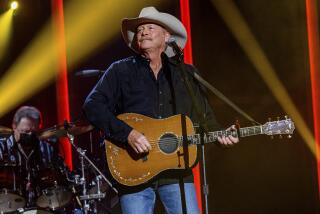Not the Keith Jarrett of Old, but Almost
- Share via
When pianist Keith Jarrett walked on stage at Royce Hall Thursday night, his presence alone was a kind of mini-miracle. Sidelined for more than two years with severe symptoms of chronic fatigue syndrome, a malady far more serious than its name implies, Jarrett made only one appearance in the interim. And that program, performed last November in New Jersey near his home, very nearly sent him into the depths of relapse.
So when Jarrett, a small, slender man--looking even more slight than he has in the past--unassumingly stepped into the spotlight, it was no surprise that the packed-to-the-rafters crowd greeted him and his associates, bassist Gary Peacock and drummer Jack DeJohnette, with a roar of applause and cheers.
But the real test came when he finally sat down at the piano, extended his arms to stretch the tension out of his fingers, and finally began to play. What emerged, initially, was less than miraculous for its content but nonetheless a joy to hear.
At his best, Jarrett was a stunning improviser, capable of generating such an imaginative flow of ideas that one could only marvel at his ability to function at such a consistently high level of creativity. As it turned out, that consistency came with a price--a physical and mental fatigue that Jarrett believes helped to establish a systemic vulnerability for the disease to strike.
Although his first few numbers were, by any evaluation, first-rate jazz improvising, they remained beneath the high bar that Jarrett has established for his own work. His opening number, “Spring Is Here,” felt a bit tentative, clearly reflective of Jarrett’s slow unlimbering with the piano, the acoustics of the hall and his long break from performing.
The energy level gradually rose as the set continued, with some especially fine Jarrett soloing on a loose swinging blues. And, in the final few numbers before intermission, his phrasing began to reveal a crisp, bebop-tinged quality, a kind of focused expansion of the Bud Powell-originated style.
The program’s second half took the music up to another level. From the first few notes of his initially disguised rendering of “What Is This Thing Called Love,” Jarrett seemed more comfortable with the music, almost as though the program’s first half had assured him that he was back in a safe place. He played a superb, right-hand-oriented solo on “Doxy” and a lovely, melodically lush version of “When I Fall in Love.”
As the concert came to a close, both Jarrett and the crowd were reluctant to see it end. Amazingly, he played three separate encores. The final was a surprise: a whimsical but insistently swinging interpretation of “Poinciana,” served up as a direct tribute to Ahmad Jamal.
And, even after that final number, there was a kind of suspended moment, as though both Jarrett and the audience were ready for more. “Play everything,” shouted one eager voice.
Jarrett just smiled and left, but the memory of the music remained. Jarrett continues to deal with his malady, but he has made a giant step back, and it should be as clear to him as it was to the audience that his music hasn’t suffered at all from the long and difficult hiatus from performing. (Jarrett also performs with Peacock and DeJohnette at San Francisco’s Masonic Hall on Sunday.)
More to Read
The biggest entertainment stories
Get our big stories about Hollywood, film, television, music, arts, culture and more right in your inbox as soon as they publish.
You may occasionally receive promotional content from the Los Angeles Times.








